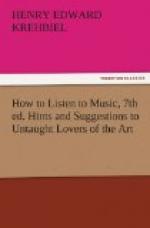[Sidenote: Pianoforte recitals.]
[Sidenote: The pianoforte’s underlying principles.]
I am not now concerned with Mr. Paderewski beyond invoking his aid in bringing into court a form of entertainment which, in his hands, has proved to be more attractive to the multitude than symphony, oratorio, and even opera. What a world of speculation and curious inquiry does such a recital invite one into, beginning with the instrument which was the medium of communication between the artist and his hearers! To follow the progressive development of the mechanical principles underlying the pianoforte, one would be obliged to begin beyond the veil which separates history from tradition, for the first of them finds its earliest exemplification in the bow twanged by the primitive savage. Since a recognition of these principles may help to an understanding of the art of pianoforte playing, I enumerate them now. They are:
1. A stretched string as a medium of tone production.
2. A key-board as an agency for manipulating the strings.
3. A blow as the means of exciting the strings to vibratory action, by which the tone is produced.
[Sidenote: Their Genesis.]
[Sidenote: Significance of the pianoforte.]
Many interesting glimpses of the human mind and heart might we have in the course of the promenade through the ancient, mediaeval, and modern worlds which would be necessary to disclose the origin and growth of these three principles, but these we must forego, since we are to study the music of the instrument, not its history. Let the knowledge suffice that the fundamental principle of the pianoforte is as old as music itself, and that scientific learning, inventive ingenuity, and mechanical skill, tributary always to the genius of the art, have worked together for centuries to apply this principle, until the instrument which embodies it in its highest potency is become a veritable microcosm of music. It is the visible sign of culture in every gentle household; the indispensable companion of the composer and teacher; the intermediary between




